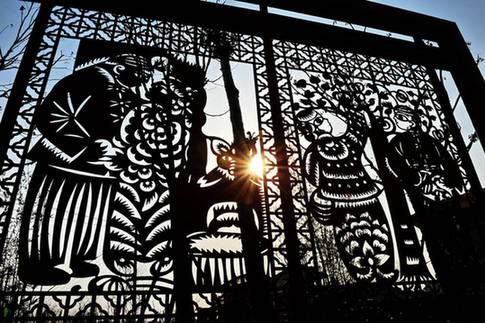| Living History at Hefei's "Culture Park"
By staff reporter VAUGHAN WINTERBOTTOM
PLAYING word association with "theme park" is fairly predictable – Mickey Mouse, roller coaster and cotton candy are the typical trio that spring to mind. But in Hefei, capital of China's Anhui Province, a fourth word is vying for space among the staples – culture. The engine behind this culture drive is the China (Hefei) Intangible Cultural Heritage Park, where the only roller coaster you'll take is the one through the annals of Chinese history. It's a great ride.
At the China Intangible Heritage Park, visitors witness master carvers chipping away at enormous, intricate wall carvings, take a look inside 400-year old bridal sedan chairs and are transported to dynasties past, and marvel at the genius of Buddhist grottoes that bejewel verdant cliff faces. As China engages in serious and important work to protect the legacy of its five millennia-long cultural traditions, Hefei's Culture Park is looked to as a paradigm of success.
|
 |
| Traditional Chinese papercuts, or Jianzhi, welcome visitors to the park. |
Culture Gains Currency
The final two decades of the 20th century were a period of remarkable improvements in the daily lives of the Chinese people. This improvement was based on basic development economics – more job opportunities and consistently rising wages are the building blocks a population needs to rise out of poverty.
As people's incomes head higher, however, other factors beside the economic begin to matter when it comes to standards of living. One is people's access to, and connection with, their own culture. In recognition of this reality, in 2003 China kicked off a nationwide campaign to search out and protect the country's unique cultural heritages and cultural relic sites.
Finding cultural heritages and relic sites proved easier than protecting them. By the early 2000s, many relic sites were in poor condition due to weather, time and, at worst, purposeful destruction and sacking for profit. Cultural heritages in the form of skills and traditions were not being passed on to younger generations.
"The question at the time was preservation and accessibility – where to house movable cultural relics and how to encourage inheritors to unique cultural heritages to congregate and pass their knowledge on to youth," says Wang Ruisong, vice president of Anhui Huajiao Group, the organization responsible for initiating and funding the park. "Rather than open another museum, we hit upon the idea of the Intangible Cultural Heritage Park as a more engaging and interactive means of amassing and sharing China's living cultural history with the general public."
| 